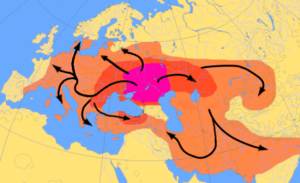Kurgan hypothesis
theory of Indo-European origin
The Kurgan model of Indo-European origins is about both the people and their Proto-Indo-European language.

It uses both archaeology and linguistics to show the history of their culture at different stages of the Indo-European expansion.
The Kurgan model is the most widely accepted theory on the origins of Indo-European.
Background
changeWhen it was first suggested in 1956, Marija Gimbutas's answer to the question of Indo-European origins was a pioneering interdisciplinary synthesis of archaeology and linguistics. From the nineties on, new archaeological evidence from Northern European prehistoric cultures was put forward on the influence and expansion of Kurgan cultures.[3]
Related pages
changeReferences
change- ↑ Mallory J.P. 1991. In search of the Indo-Europeans: language, archaeology, and myth. London: Thames & Hudson, 185. ISBN 0-500-27616-1
- ↑ Strazny, Philipp (ed) 2000. Dictionary of historical and comparative linguistics. Routledge, 163. ISBN 978-1-57958-218-0
- ↑ Dexter, Miriam Robbins & Jones-Bley, Karlene eds. 1997. The Kurgan culture and the Indo-europeanization of Europe: selected articles from 1952 to 1993. Washington, DC: Institute for the Study of Man. ISBN 0-941694-56-9